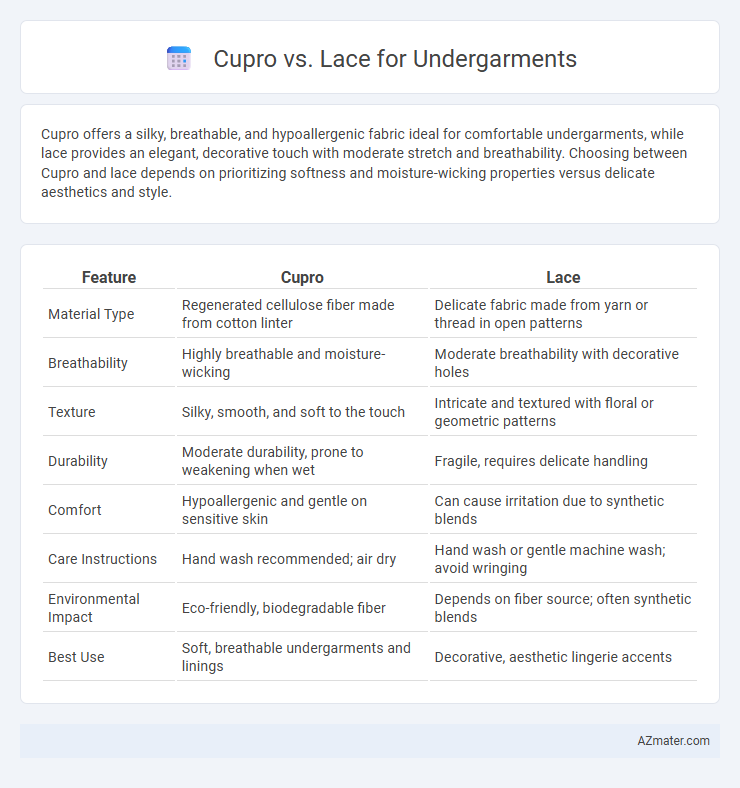Cupro offers a silky, breathable, and hypoallergenic fabric ideal for comfortable undergarments, while lace provides an elegant, decorative touch with moderate stretch and breathability. Choosing between Cupro and lace depends on prioritizing softness and moisture-wicking properties versus delicate aesthetics and style.
Table of Comparison
| Feature | Cupro | Lace |
|---|---|---|
| Material Type | Regenerated cellulose fiber made from cotton linter | Delicate fabric made from yarn or thread in open patterns |
| Breathability | Highly breathable and moisture-wicking | Moderate breathability with decorative holes |
| Texture | Silky, smooth, and soft to the touch | Intricate and textured with floral or geometric patterns |
| Durability | Moderate durability, prone to weakening when wet | Fragile, requires delicate handling |
| Comfort | Hypoallergenic and gentle on sensitive skin | Can cause irritation due to synthetic blends |
| Care Instructions | Hand wash recommended; air dry | Hand wash or gentle machine wash; avoid wringing |
| Environmental Impact | Eco-friendly, biodegradable fiber | Depends on fiber source; often synthetic blends |
| Best Use | Soft, breathable undergarments and linings | Decorative, aesthetic lingerie accents |
Introduction to Cupro and Lace Fabrics
Cupro, a regenerated cellulose fiber derived from cotton linter, offers a silky texture and excellent breathability, making it ideal for undergarments. Lace, typically crafted from cotton, nylon, or polyester fibers, provides intricate patterns and a delicate, decorative quality favored in intimate apparel. Both fabrics balance comfort and aesthetic appeal, with Cupro excelling in moisture-wicking properties and Lace emphasizing visual elegance.
Fabric Composition and Characteristics
Cupro fabric, derived from regenerated cellulose fibers made from cotton linter, boasts a silky smooth texture, excellent breathability, and natural moisture absorption, making it ideal for comfortable undergarments. Lace, typically crafted from synthetic fibers like nylon or polyester blended with elastane, offers intricate patterns, high elasticity, and lightweight durability, enhancing aesthetic appeal and flexible fit in lingerie. Cupro's hypoallergenic properties contrast with lace's delicate yet resilient structure, influencing both fabric choice based on comfort versus decorative preference in undergarment design.
Softness and Comfort Comparison
Cupro undergarments offer exceptional softness due to their silky, smooth texture derived from regenerated cellulose fibers, making them highly breathable and moisture-wicking for enhanced comfort. Lace, while elegant and decorative, typically lacks the softness of Cupro and can sometimes cause irritation or itchiness depending on the threading and finish. For everyday comfort, Cupro outperforms lace by providing a gentle, smooth feel against the skin ideal for sensitive areas.
Breathability and Moisture Wicking Abilities
Cupro fabric, derived from regenerated cellulose fibers, offers excellent breathability and superior moisture-wicking properties, making it ideal for undergarments that keep the skin dry and comfortable throughout the day. Lace, typically made from synthetic fibers or cotton blends, provides moderate breathability but lacks the effective moisture management found in Cupro, which can lead to increased discomfort during prolonged wear. For undergarments prioritizing airflow and moisture control, Cupro outperforms lace by maintaining optimal skin temperature and reducing sweat retention.
Durability and Longevity
Cupro fabric, made from regenerated cellulose fibers, offers superior durability and resistance to wear compared to delicate lace materials, which are more prone to tearing and fraying over time. The inherent strength and smooth texture of Cupro enhance the longevity of undergarments, maintaining shape and comfort even after multiple washes. Lace undergarments, though aesthetically appealing, require gentle care and limited use to preserve their intricate designs and prevent premature degradation.
Skin Sensitivity and Hypoallergenic Properties
Cupro fabric, derived from regenerated cellulose fibers, is highly breathable, moisture-wicking, and naturally hypoallergenic, making it ideal for individuals with sensitive skin prone to irritation or allergies. Lace, often made from synthetic fibers or blended materials, may cause discomfort or allergic reactions due to its coarser texture and potential chemical treatments. Choosing Cupro undergarments reduces risks of skin irritation and promotes comfort for those with sensitive or reactive skin.
Aesthetic Appeal: Texture and Design Choices
Cupro fabric offers a smooth, silky texture with a subtle sheen that enhances the aesthetic appeal of undergarments, providing a luxurious and elegant look. Lace undergarments feature intricate patterns and delicate transparency, adding a romantic and feminine touch while allowing for diverse design variations. Both materials allow for unique design choices, but cupro emphasizes sleek sophistication, whereas lace emphasizes decorative detail and sensuality.
Sustainability and Environmental Impact
Cupro, a regenerated cellulose fiber derived from cotton linter, offers a sustainable alternative to traditional fabrics with its biodegradable properties and low environmental impact during production. Lace, often made from synthetic fibers like nylon or polyester, tends to have a higher carbon footprint and contributes to microplastic pollution due to its synthetic origin. Choosing cupro-based undergarments supports eco-friendly practices by reducing reliance on petrochemical resources and promoting biodegradability in textile waste management.
Maintenance and Care Instructions
Cupro undergarments require gentle hand washing with mild detergent and air drying to maintain their silky texture and prevent fabric damage. Lace undergarments need delicate handling, preferably in a mesh laundry bag on a gentle cycle, avoiding bleach or high heat to preserve intricate patterns and elasticity. Both fabrics benefit from cool water washing and avoiding wringing or twisting to extend garment lifespan and maintain softness.
Choosing the Right Fabric for Your Undergarments
Cupro offers a silky, breathable, and moisture-wicking feel, making it ideal for undergarments that prioritize comfort and temperature regulation. Lace, while less absorbent, provides aesthetic appeal and delicate detailing suitable for enhancing visual elegance in lingerie. Choosing the right fabric depends on balancing functional needs like softness and breathability with design preferences and durability requirements.

Infographic: Cupro vs Lace for Undergarment
 azmater.com
azmater.com